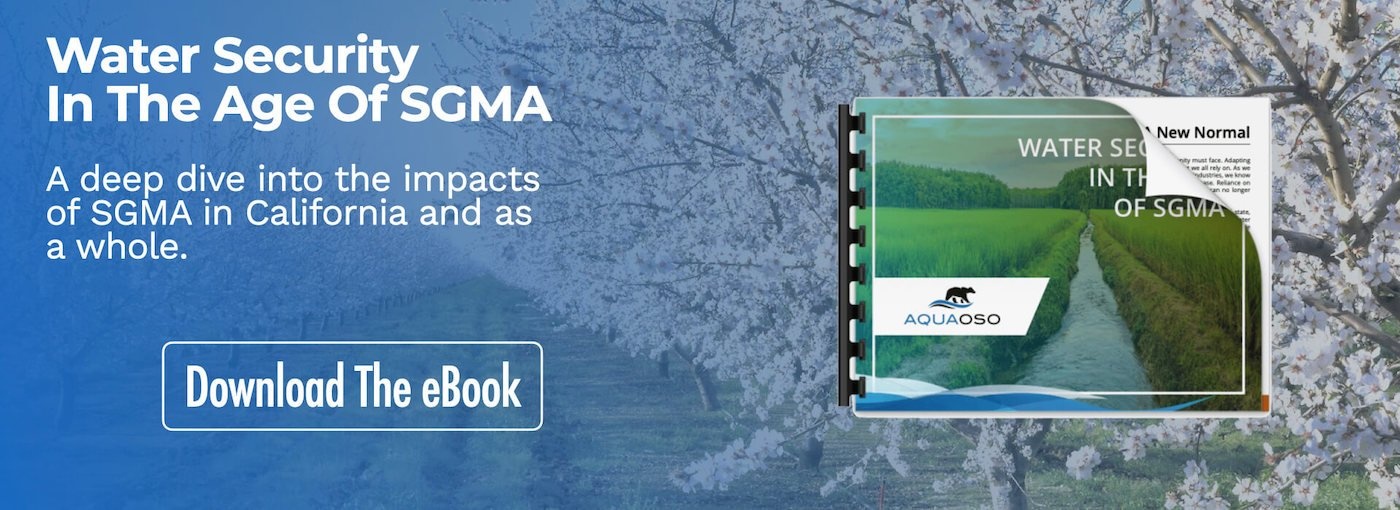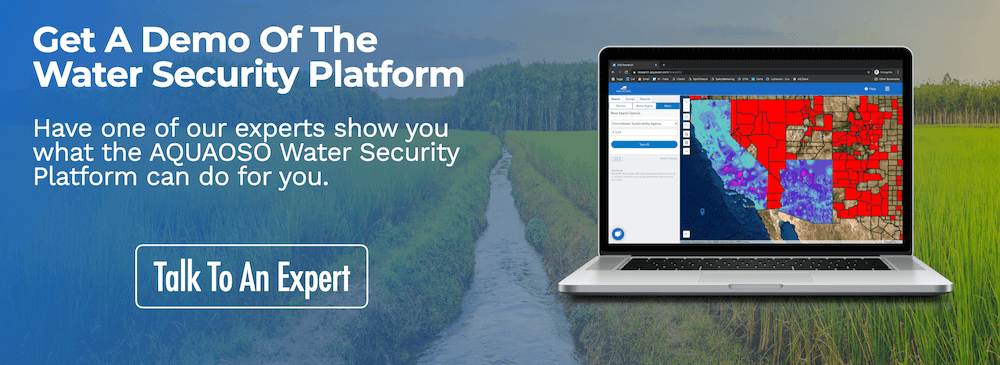Groundwater Recharge – Its Importance and Scalability
Groundwater recharge is one important way this can happen. Recharge simply refers to the replenishing of groundwater resources. This process would regularly happen naturally through rain and snowmelt. It can also be artificially induced. The important calculus is that recharge has to happen at a greater rate than water is pumped out of the aquifer.
This post looks at how groundwater recharge works, its benefits, and how it can be scaled with more funding and better water data.
Why Groundwater Recharge is Needed
The U.S.G.S. compares aquifers to a bank account. Aquifer depletion happens when water users pump more water out of the aquifer than is naturally replaced. Up to 50 billion gallons of groundwater are used every day in the agricultural sector alone.
Overpumping can result in dry wells, reduced water quality, and even land subsidence. When water is removed from the soil, the land itself can drop as the soil compacts and is unable to support the land above. Additionally, a lower water table means that wells need to be drilled deeper and may no longer be able to access as much water.
In the American West, groundwater depletion is an issue of major concern for the agriculture sector. In the west, there is less surface water available for irrigation because many ag operations sit atop groundwater. It has long been cheaper and easier to transport for operations distant from a surface water source or water conveyance infrastructure.
Because there is more groundwater than surface water, farmers and ranchers typically rely heavily on groundwater to operate their businesses. Whether water is transported in after being purchased or its origin is an already-acquired water right, much of agriculture in the West uses groundwater.
Again, as part of the water cycle, groundwater recharge would normally happen through precipitation and natural replenishment. This is when there is a natural equilibrium. However, this balance is not the case.
Simply put, climate change disrupts the water cycle, causing less precipitation than normal, while population growth and increased food demand push agricultural businesses to pump more water out of the ground. This is known as water stress and warrants artificial groundwater recharge.
Another effect of groundwater depletion is reduced surface water in lakes and streams. This is because surface water and groundwater interact in complex ways, and reduced groundwater may mean that less water flows into wetlands and other ecosystems that rely on it. The net effect can be less vegetation and diminished water quality.
Aquifer depletion affects both agricultural and municipal water users, but recharge and stewardship initiatives can help to reverse this cycle. The Nature Conservancy displays this concept in a visual way on Page 21 of their “Wellspring” report. Both upstream and downstream users can work together to maintain a healthy water cycle through “forest protection, reforestation, and improved agricultural practices.”
How Groundwater Recharge Works
Groundwater recharge can occur in one of two ways: naturally and artificially. Natural recharge can be supported by the protection of areas that are natural recharge zones such as wetlands. It can also be supported by restricting roads and paved surfaces that get in the way of rainwater and snowmelt from soaking into the ground and replenishing aquifers.
Recharge ponds and injection wells are other artificial recharge options. Recharge ponds are built on the surface of the land and “allow water to slowly infiltrate through the soil into the underground aquifer.” Injection wells are similar, but they use pumps to push the water underground at greater speed and pressure.
The water used in artificial recharge projects can come from lakes and streams when water levels are high and demand is low. Some regions, though, are going one step further and using recycled wastewater and even agricultural runoff to recharge their aquifers. Here’s how the Orange County Water District describes the process:
“The [Groundwater Replenishment System (GWRS)] takes highly treated wastewater that would have previously been discharged into the Pacific Ocean and purifies it using a three-step advanced treatment process consisting of microfiltration, reverse osmosis and ultraviolet light with hydrogen peroxide.”
Projects like these support water sustainability and are more cost-effective than their alternatives. The Stanford Woods Institute estimates that groundwater recharge projects can cost as little as $90 to $1,100 per acre-foot – compared to $2,700 for reservoir expansion projects, and over $3,000 for seawater desalination projects.
How Groundwater Recharge Can Be Scaled
Groundwater recharge projects will need to be rolled out at a greater scale in order to balance out current water trends. This will require more funding, as well as more support for water markets, so long as those markets incentivize the best use of the traded.
While buying and selling water may not seem directly related to groundwater recharge, it can have a significant effect on aquifers. For one, farmers in overdrawn basins can be incentivized to sell their water rights to places and businesses that need them more in years when water is scarce.
Groundwater markets can function as a kind of “cap and trade” system for water, with caps set by regional regulatory agencies. Some markets also allow for “water banking,” in which farmers can receive credits for water that they don’t use. These credits can be applied to future allocations. In the meantime, it can be used to recharge aquifers.
Water markets also provide an opportunity for investors to play a role in shaping the future of water conservation. In some regions, governments and private investors can purchase water from water markets in order to divert it back into nature.
California recently promised $60 million in grants to help replenish aquifers in the state’s “critically-overdrafted basins.”
The Nature Conservancy writes that these kinds of public and private initiatives “could secure a regular flow of water back to depleted ecosystems and sell the rest back to irrigators or cities on the open market – generating a material return for investors in the process.”
How AQUAOSO Supports Groundwater Recharge
Understanding the status of a region’s aquifers – and any groundwater regulations that apply to growers – is key to making good agricultural investments. AQUAOSO helps ag professionals make smarter decisions about water risk with our cloud-based Water Security Platform and Research and Reporting tools.
Users can search by APN, or point and click on the map, to locate a specific piece of farmland. They can then see which groundwater basin a parcel is in and what Groundwater Sustainability Plans apply (under California’s SGMA regulations).
With most GSAs, platform users can also see whether a GSA has published any groundwater pumping restrictions or allocations in the form of sustainable yield per acre-foot. AQUAOSO can provide groundwater allocation estimates that are based on published figures.
To date, AQUAOSO has researched over 2.03 million acres of land and completed 6500+ reports. Transparent, un-siloed data empowers smarter water decisions and assists in maintaining healthy watersheds.
Better data provides a common ground and is crucial in the resilience of our farming communities and ecosystems.
Read more about water conservation in the explorable AQUAOSO Guide.
The Bottom Line
Groundwater accounts for up to 30% of freshwater resources, but some of the nation’s most important aquifers are at risk. Groundwater recharge is a way to replenish those aquifers, either through better management of natural recharge zones or through the development of artificial recharge projects like recharge pounds and injection wells.
These initiatives stand to benefit farmers, ag finance institutions, and municipal users by supporting a more sustainable water supply. More funding will be needed, however, to scale the initiatives. Ag professionals and investors can get a better handle on groundwater recharge projects by using AQUAOSO’s Water Security Platform for data collection and research.
AQUAOSO provides a wide range of groundwater data, including recharge districts, well reports, groundwater depth data, groundwater management data, and much more.
Sign up for our newsletter to stay up-to-date on the latest water risk developments, or contact us to set up a demo of our Water Security Platform!
Recent Posts
How Fintech Can Strengthen A Borrower-Lender Relationship in Agriculture
Fintech is a catalyst of financial success for the lender, the borrower, and the building and strengthening of relationships. It gives speed, accuracy, and agility. It helps get capital to where it needs to go, faster. Methods of decision-making have...
The Best Data Visualization Tools for Ag Finance Risk Management
For ag finance professionals, there is an acute need for tools that fit the current modern landscape. Information can be difficult to procure and can even be out-of-date. As the world continues to move faster than ever before, the Harvard Business Review writes: “the...
Fast Company awards AQUAOSO as honorable mention on first Next Big Things in Tech list
PRESS RELEASE For Immediate Release The climate fintech company’s innovative GIS Connect tool provides a richer understanding of disparate datasets in a single geospatial view, empowering agricultural organizations to create long-term resilience DENVER — (Nov....





